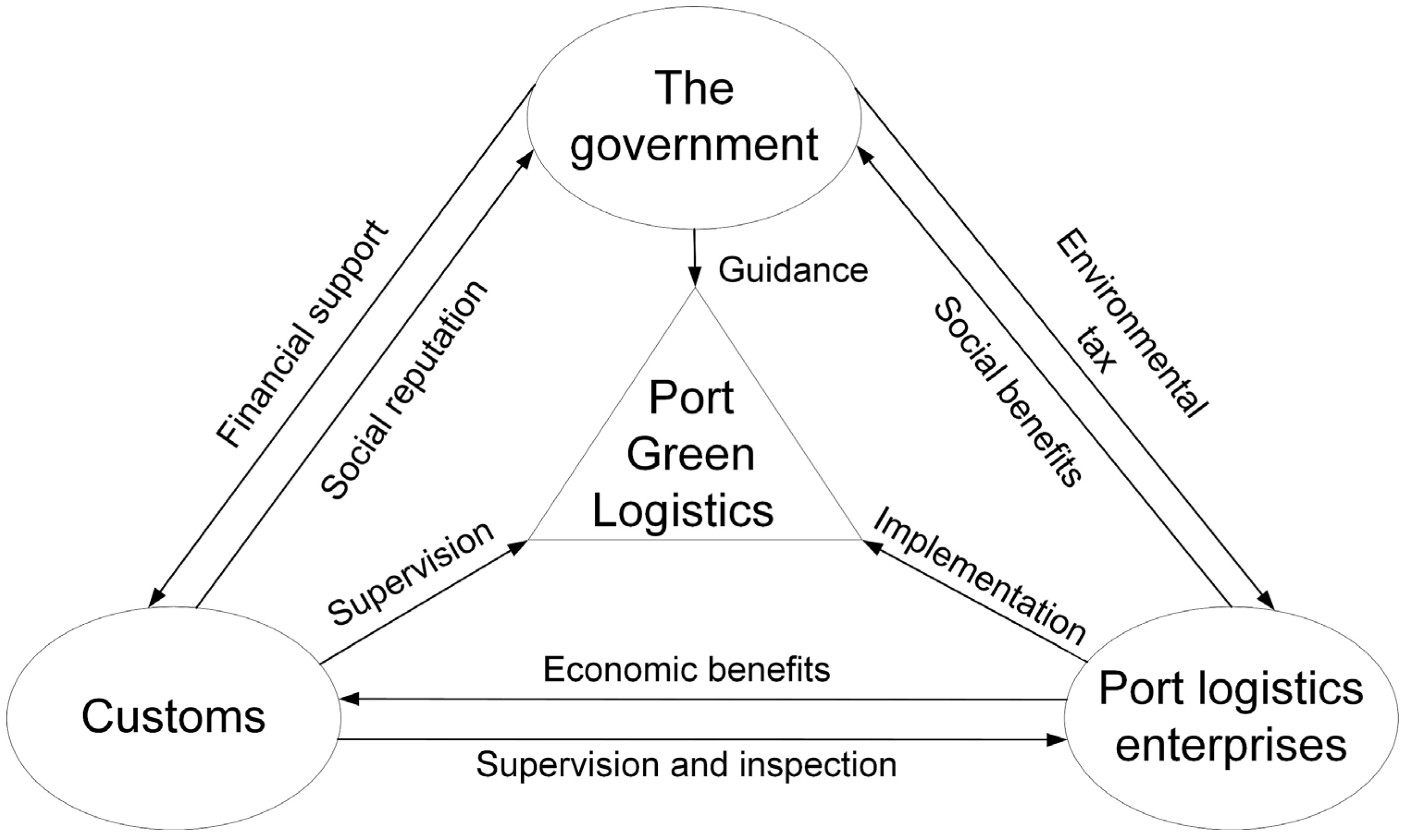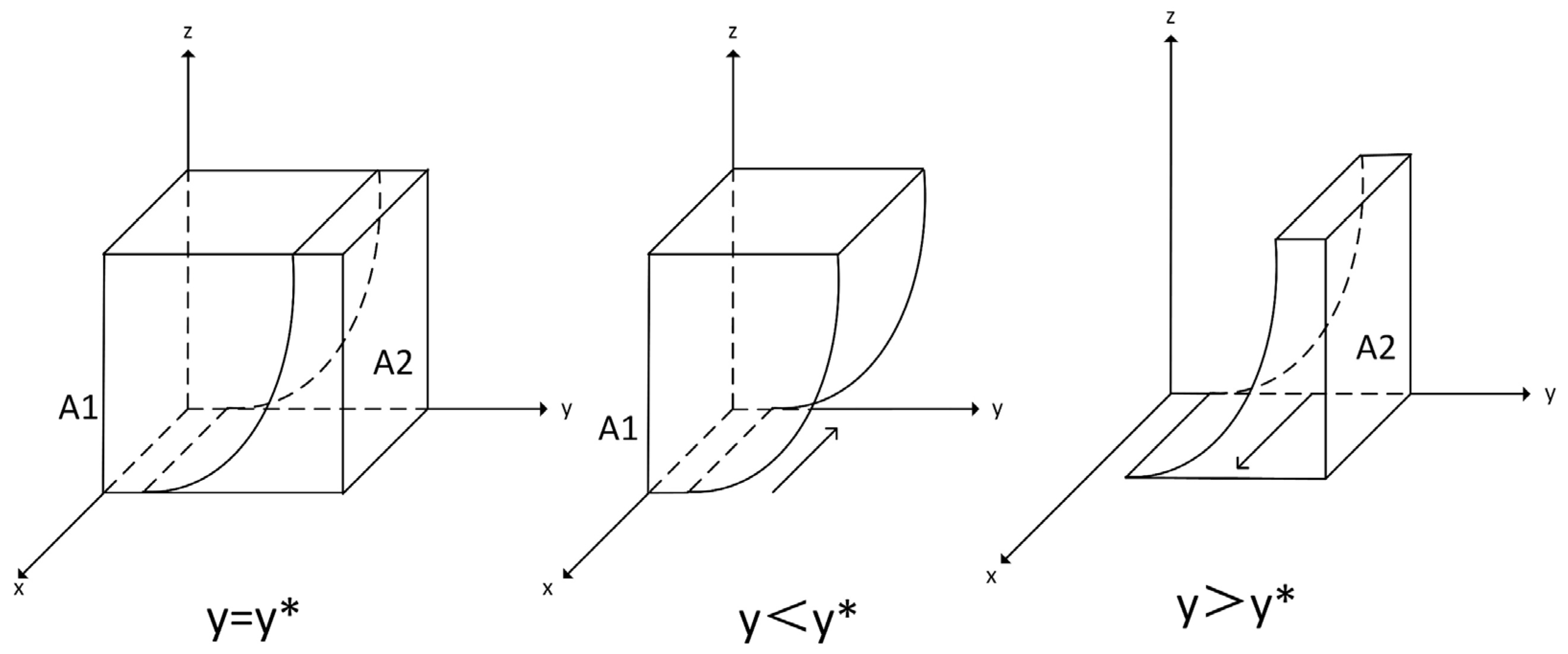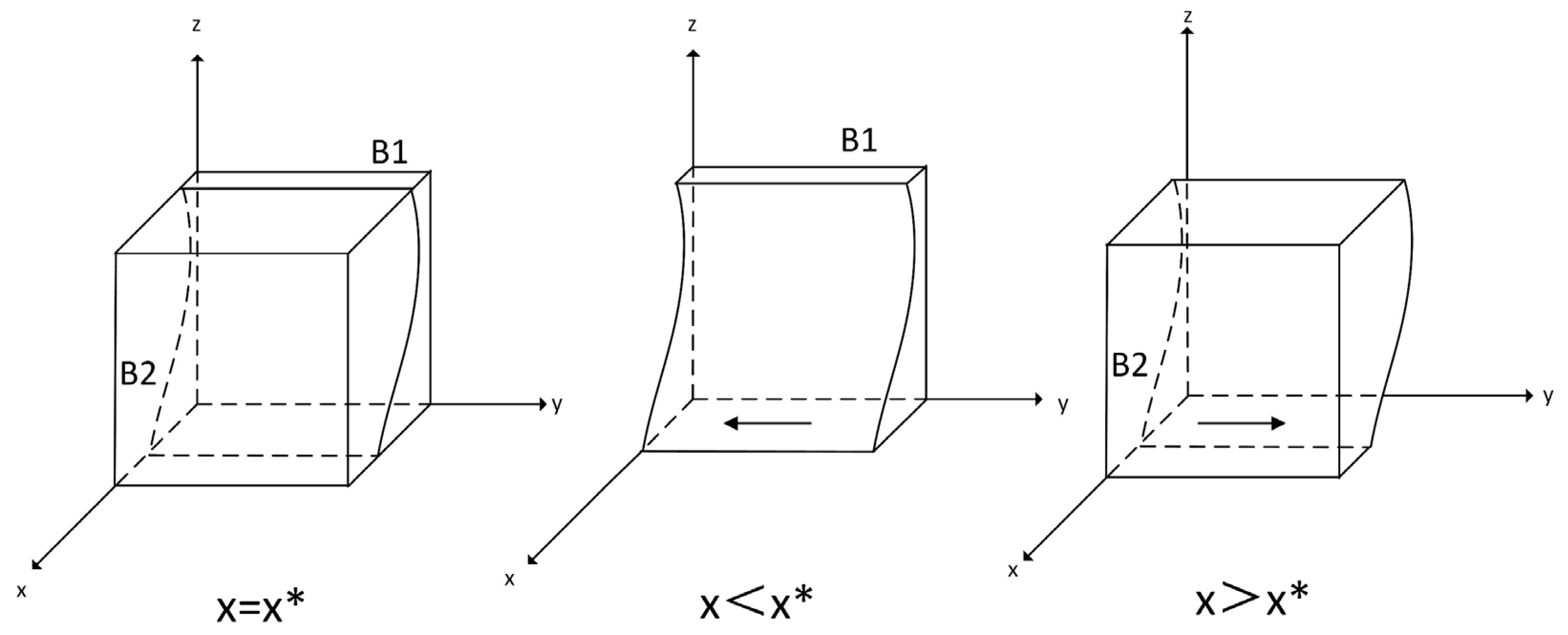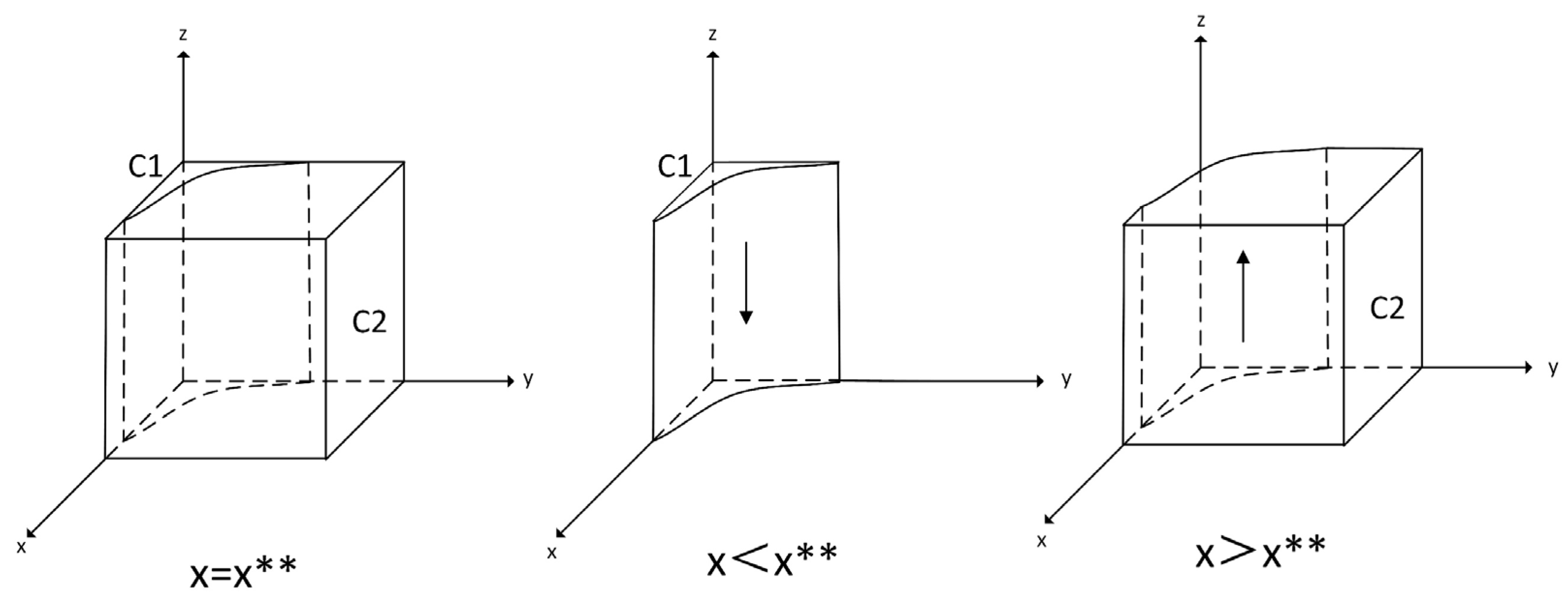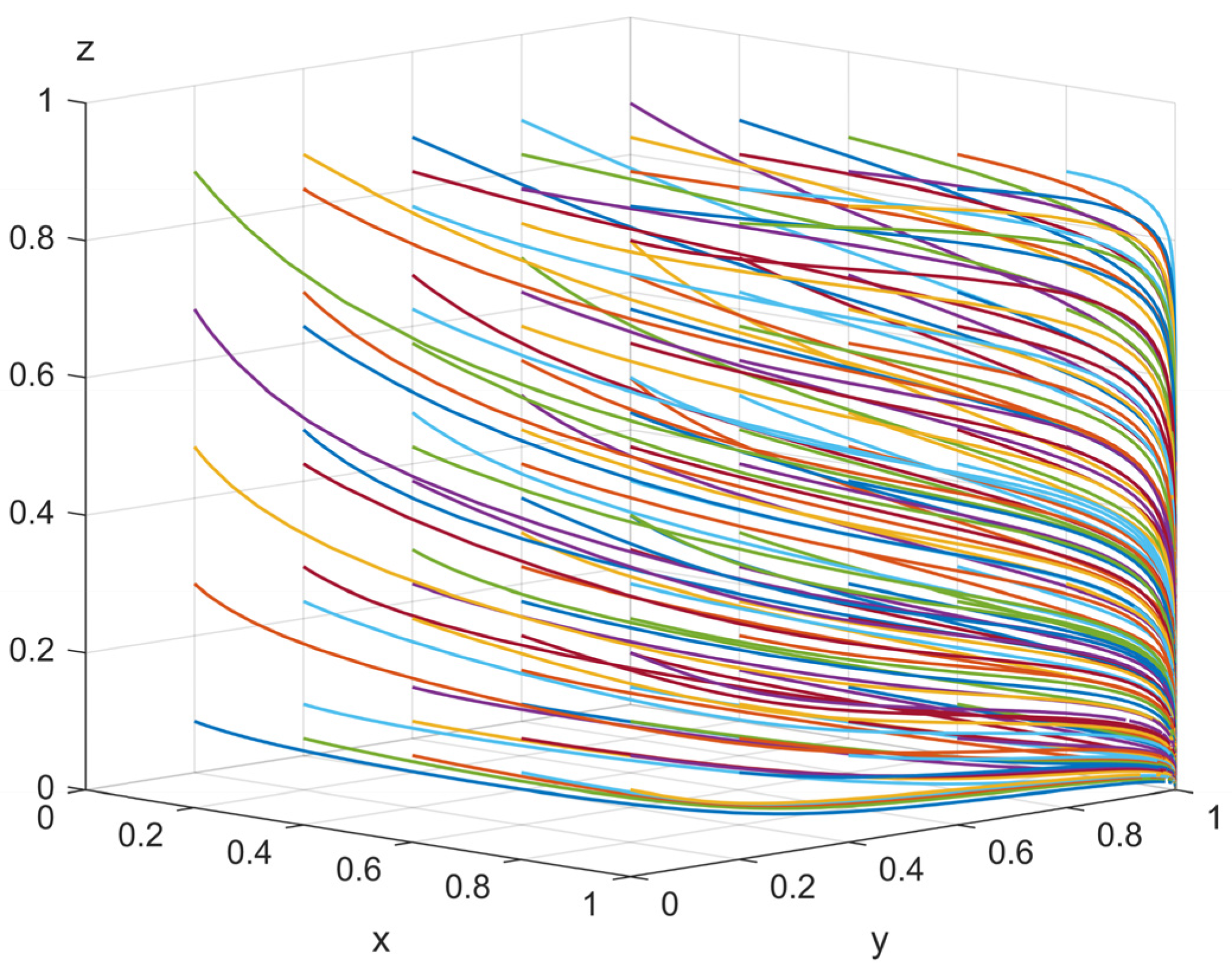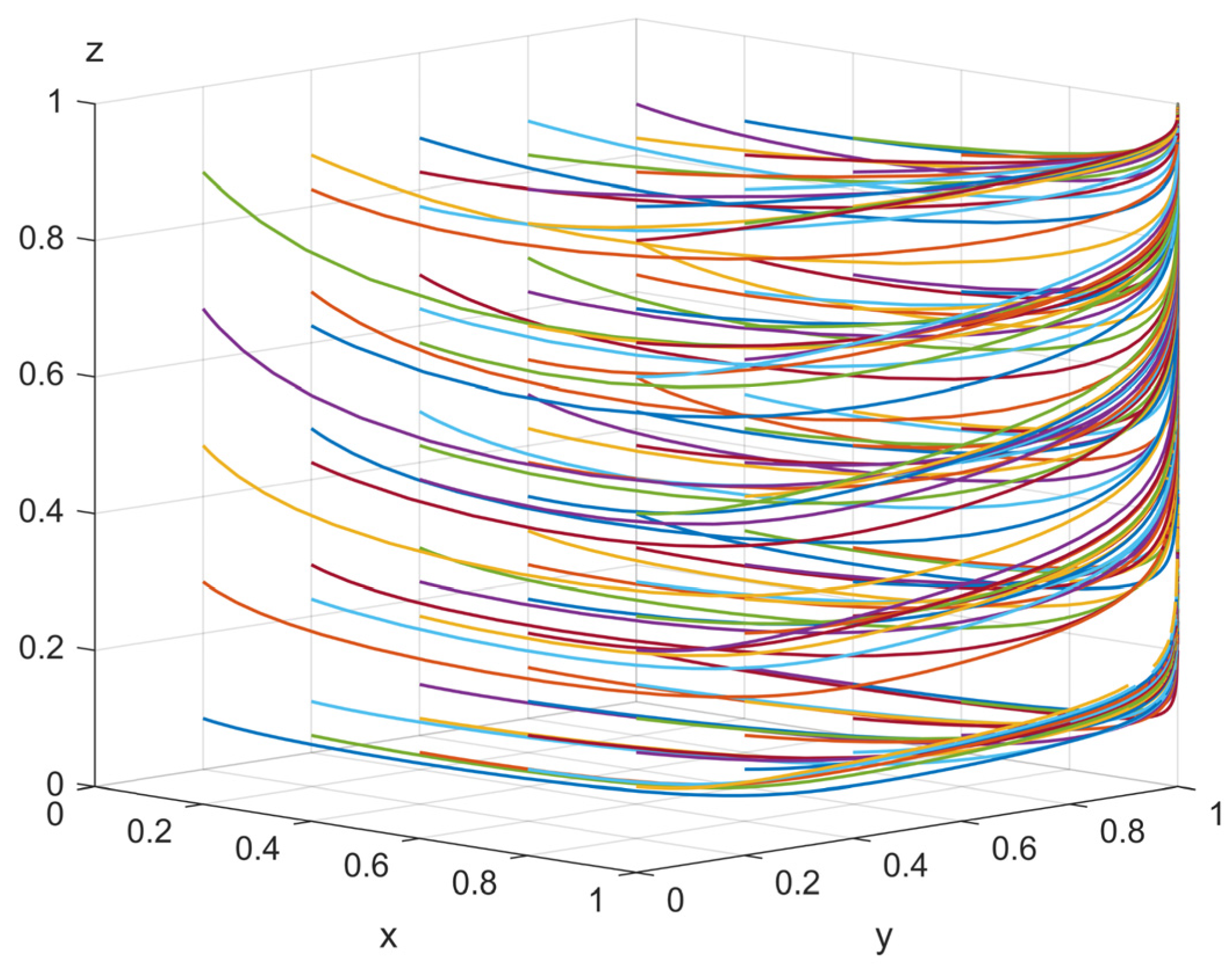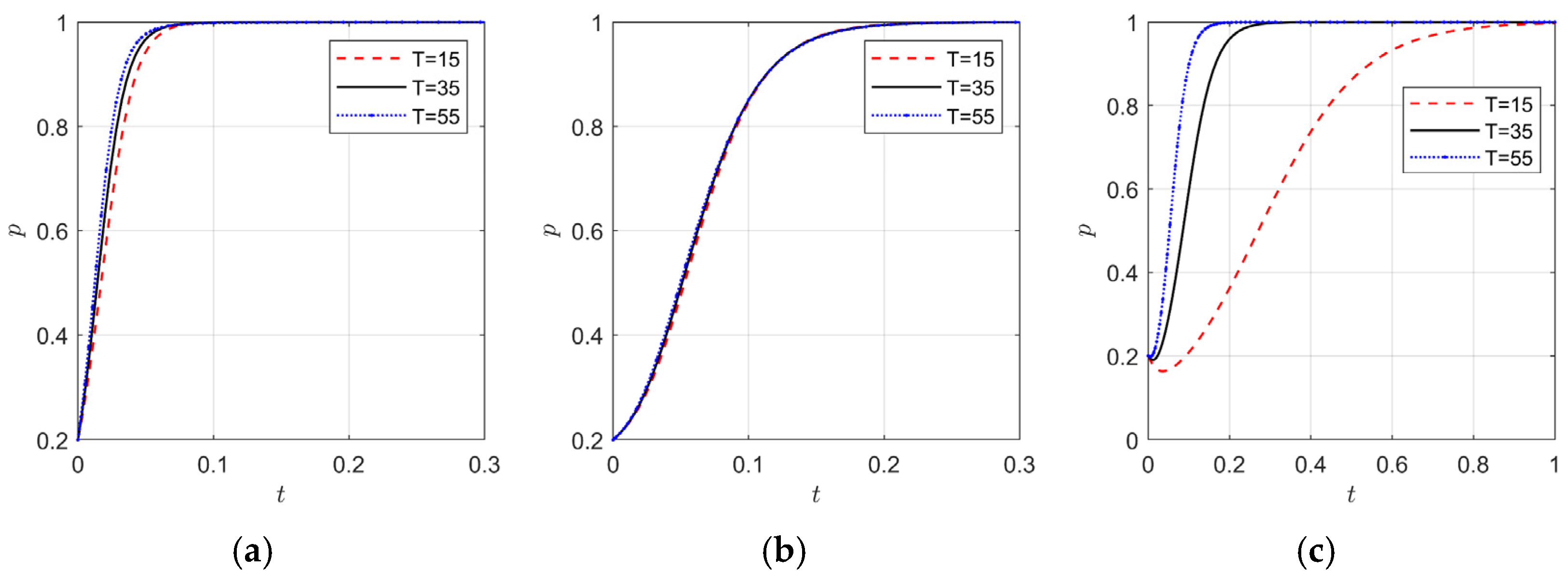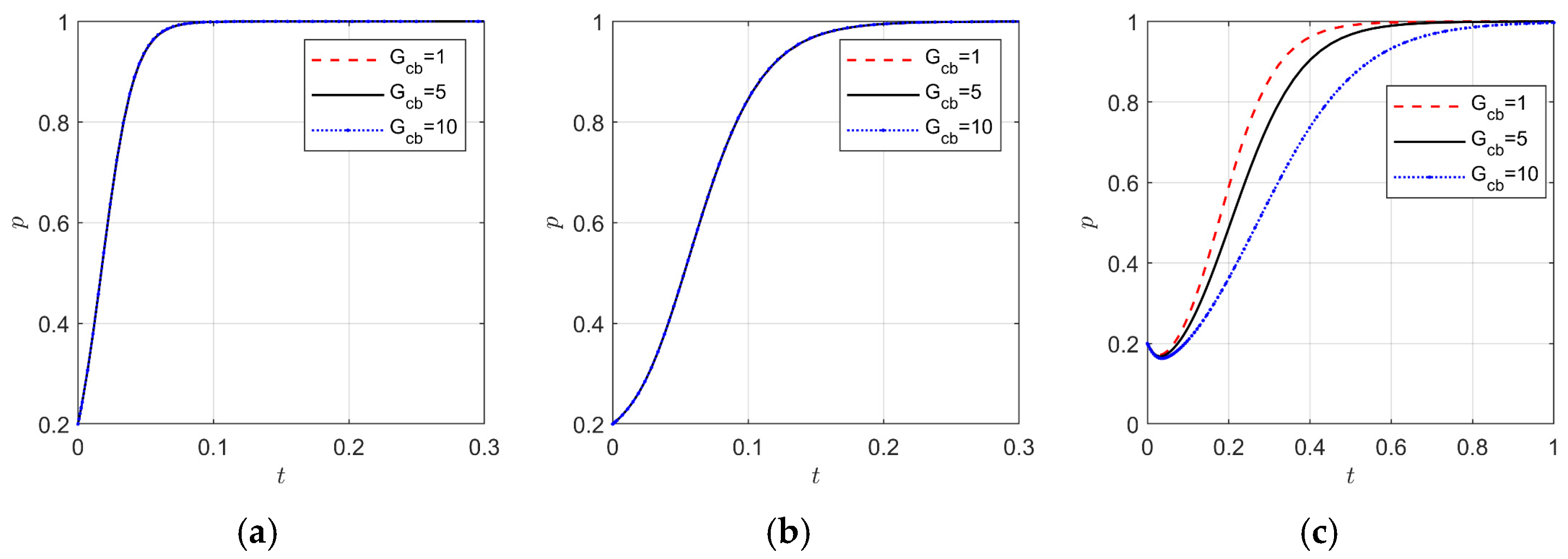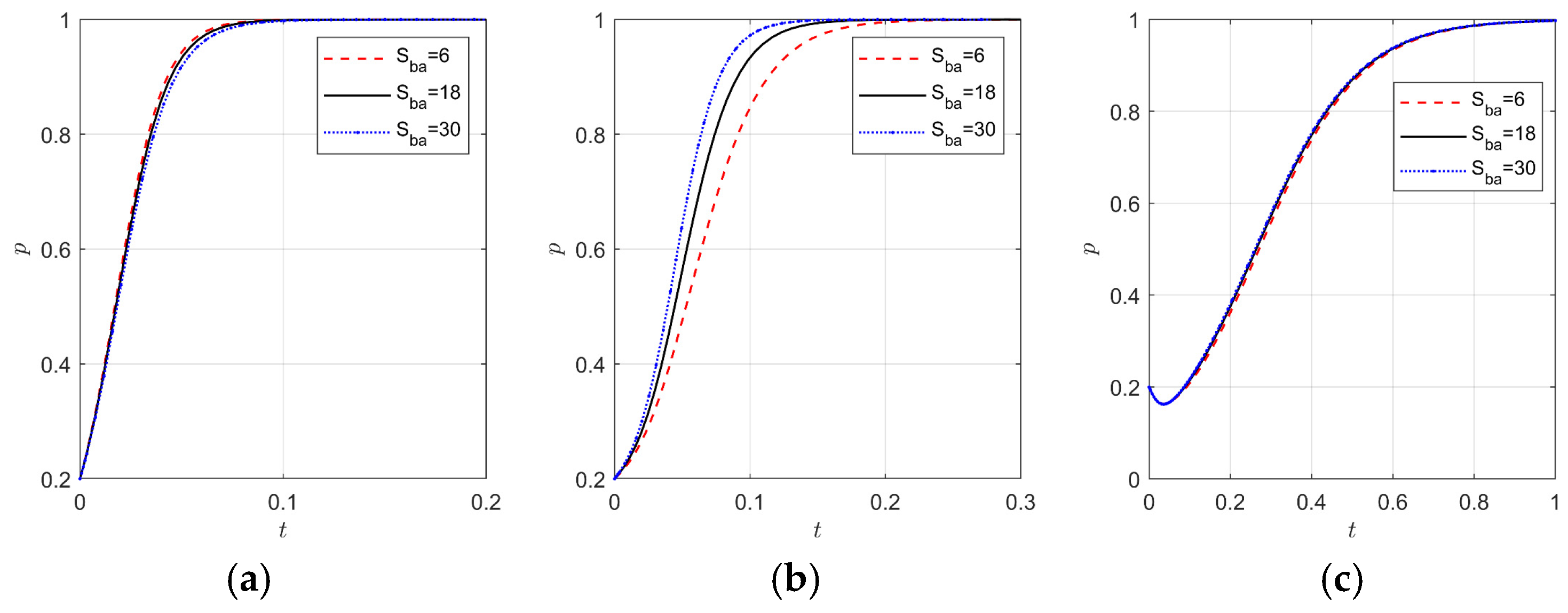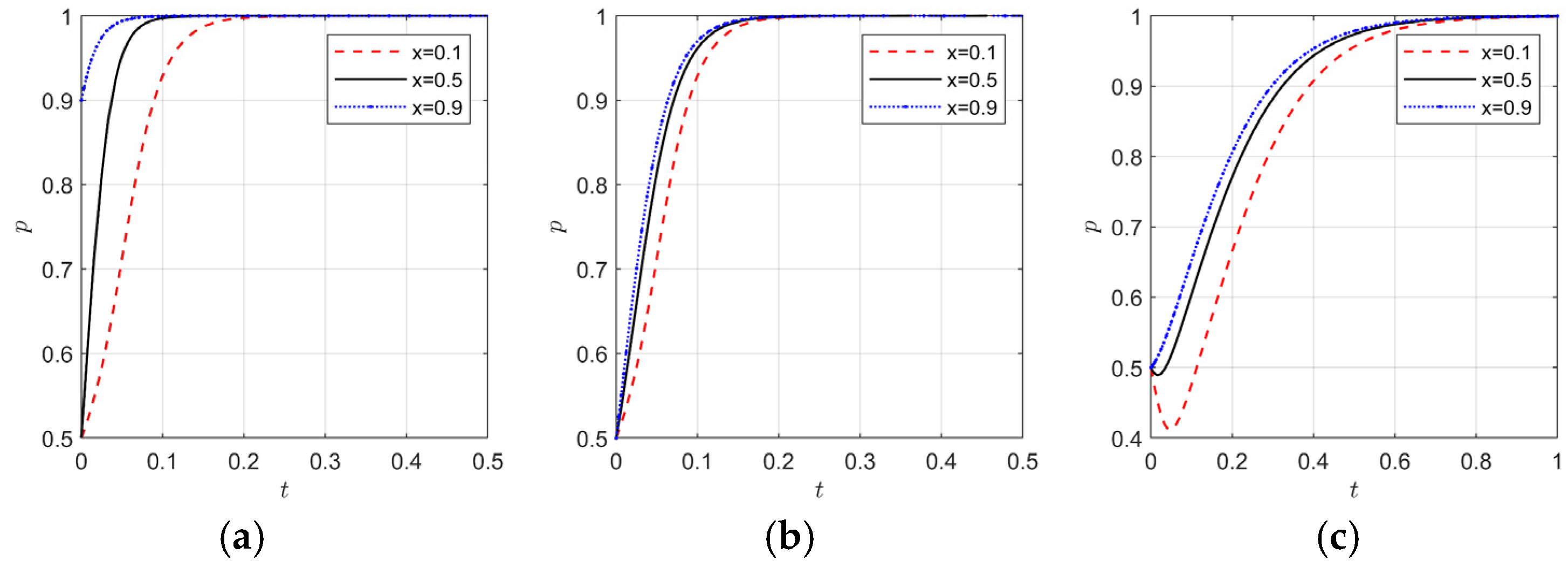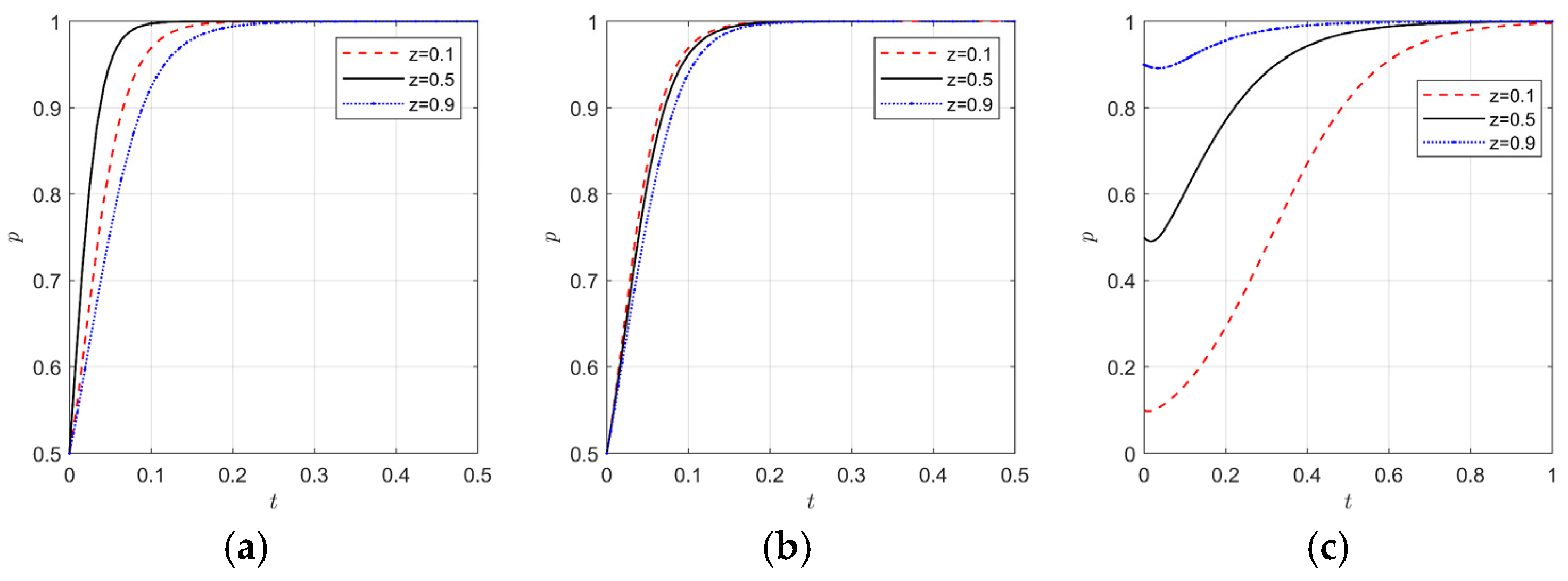1. Introduction
Amidst the tide of globalization, international trade is flourishing, and ports, as the frontier of national openness, are closely linked to economic growth and the international image of a country [
1]. With environmental issues becoming increasingly prominent, the concept of green development has gained widespread acceptance, becoming a global consensus [
2]. Against this backdrop, the “National Five-Year Plan for Port Development (2021–2025)” has envisioned an ambitious blueprint for the construction of green ports, emphasizing the urgency and significance of promoting greening and low-carbon transformation of ports in the new era. The Ministry of Transport, in conjunction with the General Administration of Customs and several other departments, has issued the “Guidelines on Building World-Class Ports”. These guidelines clearly state that by 2025, significant breakthroughs in the green development of major ports should be achieved, and by 2035, these ports are expected to lead the global development of green ports. The tasks involved include improving the collection and distribution system, preventing and controlling ship pollution, and constructing a low-carbon energy use system. Local customs authorities are actively implementing these measures. For instance, Tianjin Customs has promoted the optimization of operational processes at Tianjin Port, embedding customs instructions into the port system to achieve synchronized operations, reducing energy consumption, and supporting innovation in pilot free trade zones to enhance logistics efficiency. Ningbo Customs, on the other hand, focuses on ensuring the security of green energy, opening a “green channel” for LNG refueling, optimizing regulatory processes, and promoting convenient measures such as “one-time inspection” to assist the green transformation of the port. The construction of green ports is not only a strong reflection of China’s commitment to addressing global environmental issues but also an internal imperative for optimizing the domestic economic structure and advancing towards high-quality development [
3].
Port logistics, serving as a crucial link in international trade, occupies a central position in the process of green port construction [
4]. Numerous scholars, such as Lam and Yap, have identified market participants and public policy makers as significant categories in their analysis of stakeholders in green port construction [
5]. Among them, port logistics enterprises, as typical market participants, engage in operations that span the entire process of physical goods flow, including collection and distribution, customs clearance, loading and unloading, handling, storage, distribution processing, transportation, and delivery [
6]. These stages are closely related to the utilization of port resources, energy consumption, and emission of pollutants. However, research by Liu, Zhao, and Li has found that enterprises face the dilemma of high costs and long return periods when adopting green technologies to update basic facilities like storage facilities and transportation tools, as well as implementing green operational processes [
7]. Li and Wang, focusing on enterprise logistics and green transformation, have studied the obstacles and strategies in the transition from traditional logistics to green logistics, revealing conflicts of interest among the main actors involved in green logistics, mutual strategic games, and additional challenges such as insufficient internal motivation within enterprises, inadequate external pressure, and a lack of logistics capabilities and supporting equipment, making the process of greening enterprise logistics particularly arduous [
8]. This short-term imbalance between economic benefits and environmental benefits significantly reduces the enthusiasm of port logistics enterprises to participate in the construction of green ports actively.
Therefore, relying solely on the spontaneous regulatory mechanisms of the market, it is challenging to effectively encourage port logistics enterprises to participate in the grand tide of green port construction; strong guidance and regulation from government sectors are imperative. Tseng and Pilcher proposed the regulatory approach of imposing emission taxes to reduce the emission of pollutants from ports and ships [
9]. Wu, Junni, and others analyzed the decision-making regarding the use of shore power for ports and ships under the policy backdrop of government-imposed carbon taxes, demonstrating the incentive effect of carbon taxes in promoting the adoption of shore power facilities by ports [
10]. Dai and colleagues suggested that the government should shift subsidies from the initial stage of shore power construction to the operational phase, attracting port enterprises and ships to retrofit shore power facilities by offering subsidies on electricity prices [
11]. Lu and Wang Huibo used evolutionary game theory to explore the ways for the government to guide port enterprises to participate in the construction of green ports [
12]. The aforementioned studies have proven that the government can lower the cost of green transformation for enterprises and enhance their enthusiasm through financial incentives such as subsidies and tax preferences. However, the implementation of government policies faces numerous challenges in practice, such as insufficient subsidy strength due to limited local finances and regulatory loopholes in the policy execution process, which affect the effectiveness of policy implementation.
Customs, as a significant force in port management, has been somewhat overlooked in previous research regarding its unique impact on the green transformation process of port logistics enterprises. Acting as a vertically managed department established by the central government to supervise and manage the import and export activities at the local level, customs play an indispensable role in port construction [
13]. Liang Xingying has proposed that to meet the strategic demands of port cities and port economies, as well as regional economic development under the globalized context, customs must accurately position themselves in terms of regulatory philosophy, regulatory space, methods, and tools, thereby promoting rapid port economic growth [
14]. Xu Dao has studied the situation and challenges faced by customs in terms of clearance supervision, suggesting the active exploration of new regulatory approaches and methods that integrate with modern logistics and align with international standards, aiming to establish a new model for convenient and efficient port clearance [
15]. However, traditional research has primarily focused on the essential functions of customs, such as the supervision of import and export goods and the collection of tariffs, neglecting its potential influence in the construction of green ports. In recent years, a small number of studies have begun to focus on this area. Tao Weilian and Cai Ying have suggested that customs, as a national agency for exit supervision and management, should leverage its functional advantages, promptly incorporate the “dual carbon” goals into policy objectives, actively participate in the construction of a green trade system, vigorously promote the green development of the foreign trade industry chain, and advance the optimization and sustainable development of China’s foreign trade structure [
16]. Han Chengguo and Zhao Jiuxian, among others, have pointed out that customs, with its direct jurisdiction over bonded warehouses and frequent inspection activities, has a deep reach into every corner of these facilities, enabling it to grasp the operational details of port logistics enterprises in real-time [
17]. Consequently, customs have an informational advantage over environmental protection departments. They can promptly identify logistics operations that do not meet green standards, such as excessive use of packaging materials and energy waste in storage environments. Additionally, customs possess unique management strengths. Its vertical management model ensures the independence, authority, and unity of its regulatory powers [
13], allowing it to execute green regulatory policies strictly and avoid improper interference from local governments when faced with complex local interests. For instance, customs can integrate green logistics requirements into the declaration standards for bonded warehouses, and issue targeted green transformation directives for existing bonded warehouses, effectively promoting the green transformation of port logistics. Tianjin Customs has carried out reforms for the logistics customs clearance of import and export goods at maritime ports, embedding customs operation instructions into the port operation system to achieve synchronized and concurrent operations between customs and the port. This has facilitated the simultaneous unloading, sorting, and removal of imported goods, and the intelligent dispatching of exported goods through the port’s “dual-gate channel”, significantly enhancing inspection efficiency, reducing the frequency of cargo handling and transportation, and minimizing unnecessary losses, thereby promoting the construction of green ports from a practical operational perspective. Therefore, introducing customs as a player in the game theory analysis of green port construction, which involves multiple parties, is of vital importance for perfecting the theoretical framework and guiding practical operations. However, there is currently no mature theoretical system regarding how customs can systematically participate in the construction of green ports, especially concerning its role in the tripartite interaction among local governments, customs, and port logistics enterprises.
Therefore, this study focuses on the local government, customs, and port logistics enterprises as three key players, delving deeply into their decision-making behaviors and evolutionary strategies in the context of green port construction. By dissecting the complex interplay of interests and collaborative relationships among these three parties, the aim is to fill the existing research gaps and provide innovative theoretical support and practical guidance for promoting green port construction. Through the construction of a tripartite evolutionary game model, this study will offer theoretical guidance and practical recommendations for green port construction, facilitate the green transformation of port logistics enterprises, achieve sustainable development of ports, and support China’s steady progress on the dual track of international trade and environmental protection.
The remaining parts of the paper are structured as follows:
Section 2 presents the literature review.
Section 3 proposes assumptions and calculates the payoff matrix.
Section 4 calculates the equilibrium strategies of the local government, customs, and port logistics enterprises and conducts a stability analysis of the game system.
Section 5 uses simulation to verify the theoretical analysis conducted earlier.
Section 6 discusses the main conclusions and indicates future research directions.
2. Literature Review
With the increasing awareness of environmental protection, the construction of green ports has become a significant research topic in the field of maritime transportation. Green ports aim to minimize the negative environmental impacts of port operations while maximizing economic benefits. Studies have shown that green port initiatives can effectively reduce carbon emissions, pollution, and energy consumption, thereby promoting sustainable development. For example, Ye et al. developed a three-tier supply chain model to investigate the adoption of shore power by shipping companies, highlighting the importance of government subsidies in promoting green practices [
18]. Similarly, Song et al. analyzed the impact of government subsidies on shipping companies’ shore power usage strategies, demonstrating that subsidies can significantly improve the utilization rate of shore power and mitigate the prisoner’s dilemma situation [
19].
Building on the foundation of green port construction, research on green port logistics has gained momentum. Green port logistics focuses on optimizing the entire logistics chain within the port area to reduce environmental footprints. This includes the use of renewable energy, efficient transportation systems, and innovative logistics management practices. For instance, Zhang et al. proposed a mixed integer linear programming model to optimize the deployment of shore hydrogen in green ports, aiming to maximize port profits while promoting hydrogen energy consumption [
20]. Additionally, Wang et al. investigated integrated energy management and operations planning in oil–electric hybrid container terminals, developing a heuristic algorithm to balance operational efficiency and energy management [
21].
Customs play a crucial role in the development of green logistics. As the regulatory body overseeing international trade and transportation, customs have the authority to implement policies and regulations that promote sustainable practices. Over time, the functions of customs have evolved from traditional regulatory roles to more proactive roles in environmental protection and sustainability. For example, the implementation of “green channels” for environmentally friendly goods and the promotion of digital customs clearance systems have significantly improved the efficiency of green logistics operations [
22]. Moreover, customs have been actively involved in the development of green port policies, working closely with port authorities and logistics companies to ensure compliance with environmental standards [
23].
In recent years, the functions of customs in green logistics have undergone significant changes. Initially, customs primarily focused on regulatory compliance and trade facilitation. However, with growing environmental concerns, customs have expanded their scope of functions to include the promotion of green logistics practices and the enforcement of environmental regulations. This evolution has been driven by the recognition that sustainable practices not only benefit the environment but also enhance the overall efficiency of logistics operations [
24]. For example, customs have implemented risk management systems to identify and prioritize high-risk shipments, thereby reducing the need for extensive inspections and improving the speed of green logistics operations. Additionally, customs have been at the forefront of adopting new technologies, such as blockchain and artificial intelligence, to enhance transparency and traceability in supply chains [
25].
Given the complex interactions among various stakeholders in green logistics, game theory has emerged as a valuable research method. Game theory provides a framework for analyzing strategic interactions and decision-making processes among multiple players, such as governments, port operators, shipping companies, and customs authorities. For example, Deng et al. constructed a tripartite evolutionary game model to study the impact of environmental regulation on green port construction, emphasizing the importance of cooperation among different stakeholders [
26]. Similarly, Xu et al. used an evolutionary game model to analyze the behavior strategies of multiple stakeholders in maritime shore power systems, demonstrating that government incentives play a crucial role in promoting the adoption of green technologies [
27]. These studies show that game theory can provide valuable insights into the dynamics of green logistics and help identify effective strategies for promoting sustainable practices.
In conclusion, the construction of green ports and the development of green logistics have become essential for addressing environmental challenges in the port and logistics industry. The role of customs has significantly evolved in this process, with customs now actively promoting and enforcing green logistics practices. Game theory has proven to be a useful tool for analyzing the strategic interactions among stakeholders and identifying effective policy measures. Therefore, this paper introduces customs as a third-party regulator, working together with governments and port logistics enterprises to advance the development of green port logistics. It explores how the interactions among these three parties can further promote the sustainable development of ports and logistics transportation.
4. Model Analysis
4.1. Evolutionary Stability of the Local Government Strategy
The expected payoffs for the local government when adopting “active regulation” (
E11) and “passive regulation” (
E12) are as follows:
Subsequently, the average expected payoffs for these two strategies, denoted as
, can be computed.
Therefore, the replicator dynamic equation for the local government’s strategy choice is given by the following:
The first-order derivative of
x and the function
G(
y) are defined as follows:
According to the Lyapunov stability theorem, for the probability of the local government adopting active regulation to be in a stable state, it must satisfy F(x) = 0 and .
If , , , then G(y) = 0, ; hence, any strategic choice of the local government is a stable strategy and will not change over time.
If , to ensure F(x) = 0, the two equilibrium points corresponding to x = 0 and x = 1 can be further analyzed by differentiating the evolutionary equation concerning F(x), which leads to the following:
When x = 0, G(y) < 0. Given , it follows that G(y) is increasing concerning y; thus, if y < y*, when the local government’s strategy is located in space A1, x = 0 is an evolutionarily stable strategy (ESS), indicating that the government will choose to regulate passively.
When x = 1, G(y) > 0. Given , y > y*, when the local government’s strategy is located in space A2, x = 1 is an evolutionarily stable strategy(ESS), indicating that the government tends to regulate actively.
The evolutionary phase diagram for the strategy of the local government is shown in
Figure 2.
4.2. Evolutionary Stability of the Customs Strategy
The expected payoffs for customs when choosing “participatory supervision” (
E21) and “non-participatory supervision” (
E22) are as follows:
Subsequently, the average expected payoffs for these two strategies, denoted as
, can be computed:
Therefore, the replicator dynamic equation for the customs’ strategy choice is given by the following:
The first-order derivative of
y and the function
J(
x) are defined as follows:
According to the Lyapunov stability theorem, for the probability of customs adopting active regulation to be in a stable state, it must satisfy F(y) = 0 and .
If , then J(x) = 0, ; hence, any strategic choice of the customs is a stable strategy and will not change over time.
If , to ensure F(y) = 0, the two equilibrium points corresponding to y = 0 and y = 1 can be further analyzed by differentiating the evolutionary equation concerning F(y), which leads to the following:
When y = 0, J(x) < 0. Given , it follows that J(x) is increasing concerning x; thus, if x < x*, when the customs authority’s strategy is located in space B1, y = 0 is an evolutionarily stable strategy (ESS), indicating that the customs authority tends to choose not to regulate.
When y = 1, J(x) > 0. Given , x > x*, when the customs authority’s strategy is located in space B2, y = 1 is an evolutionarily stable strategy (ESS) for the customs authority, indicating that it will choose to engage in regulation.
The evolutionary phase diagram for the strategy of the customs is shown in
Figure 3.
4.3. Evolutionary Stability of the Port Logistics Enterprise Strategy
The expected payoffs for port logistics enterprises when choosing “green transformation” (
E31) and “traditional production” (
E32) are, respectively, as follows:
Subsequently, the average expected payoffs for these two strategies, denoted as
, can be computed:
Therefore, the replicator dynamic equation for port logistics enterprises’ strategy choice is given by the following:
The first-order derivative of
z and the function
H(
x) are defined as follows:
According to the Lyapunov stability theorem, for the probability of port logistics enterprises adopting active regulation to be in a stable state, it must satisfy F(z) = 0 and .
If , then H(x) = 0,; hence, any strategic choice of the port logistics enterprises is a stable strategy and will not change over time.
If , to ensure F(z) = 0, the two equilibrium points corresponding to z = 0 and z = 1 can be further analyzed by differentiating the evolutionary equation concerning F(z), which leads to the following:
When z = 0, H(x) < 0. Given , it follows that H(x) is increasing concerning x; thus, if x < x**, when the strategy of the port logistics enterprise is located in space C1, z = 0 is an evolutionarily stable strategy (ESS), indicating that the enterprise tends to choose traditional production. When z = 1, H(x) > 0. Given , x > x**, when the strategy of the port logistics enterprise is located in space C2, z = 1 is an evolutionarily stable strategy (ESS) for the port logistics enterprise, indicating that it will choose to undertake green transformation.
The evolutionary phase diagram for the strategy of the port logistics enterprises is shown in
Figure 4.
4.4. Evolutionary Stability Analysis
4.4.1. Equilibrium Points
Equations (4), (10), and (16) form a three-dimensional dynamical system of evolutionary game theory. Let
represent the equilibrium points, and we can obtain eight local equilibrium points for the three-dimensional dynamical system, which are
E1(0,0,0),
E2(1,0,0),
E3(0,1,0),
E4(0,0,1),
E5(1,1,0),
E6(1,0,1),
E7(0,1,1), and
E8(1,1,1). These eight equilibrium points constitute the boundary of the evolutionary game solution for the tripartite game, and the area enclosed by these boundaries (Ω) is the equilibrium solution domain of the three-party evolutionary game:
When a mixed strategy
E9(
x*,
y*,
z*) exists, satisfying Equation (4), and belongs to the equilibrium solution domain Ω,
E9(
x*,
y*,
z*) is a balance point within the system; otherwise, it is not [
29].
4.4.2. Equilibrium Stability Analysis
The Jacobian matrix for the tripartite evolutionary game system is given by the following:
According to Wainwright’s perspective, evolutionarily stable strategies (ESSs) can only be achieved in a three-dimensional dynamical system when the equilibrium point is a pure strategy Nash equilibrium, whereas
E9(
x*,
y*,
z*) is a mixed-strategy Nash equilibrium, so it can be directly disregarded [
30]. The eight equilibrium points obtained from the replicator dynamic equations are introduced into the Jacobian matrix for analysis.
Using the Lyapunov first method, if all eigenvalues of the Jacobian matrix have negative real parts, the equilibrium point is asymptotically stable; if at least one eigenvalue of the Jacobian matrix has a positive real part, the equilibrium point is unstable; if all eigenvalues of the Jacobian matrix, except for those with zero real parts, have negative real parts, then the equilibrium point is in a critical state, and the stability cannot be determined by the sign of the eigenvalues. The stability analysis of each equilibrium point is shown in
Table 3.
Scenario 1: When , the replicator dynamic system has only one stable equilibrium point E5(1,1,0); at this time, E5(1,1,0) is an evolutionarily stable strategy, meaning the government adopts an “active regulation” strategy, customs adopt a “participatory supervision” strategy, and port logistics enterprises choose the “traditional production” strategy. This indicates that, although customs’ “participatory supervision” reduces the cost of enterprise “green transformation”, the reduction is limited, and the actual “green transformation” cost is still higher than the environmental tax imposed by the government, leading to a lack of motivation for enterprises to undertake “green transformation”. At this point, it is necessary for the government to further increase the regulatory efforts on port logistics enterprises, such as raising environmental taxes and other measures, to encourage enterprises to move towards “green transformation”.
Scenario 2: When , the replicator dynamic system has only one stable equilibrium point E8(1,1,1); at this time, E8(1,1,1) is an evolutionarily stable strategy, meaning the government adopts an “active regulation” strategy, customs adopt a “participatory supervision” strategy, and port logistics enterprises choose the “green transformation” strategy. This indicates that with the continuous improvement of government regulatory measures, more robust support is provided for customs “participatory supervision”, increasing the intensity of customs supervision, which further reduces the cost of enterprise “green transformation”. At the same time, the environmental tax imposed by the government is higher than the actual transformation cost when enterprises undertake “green transformation”, thus encouraging port logistics enterprises to prefer “green transformation”, achieving the joint promotion of green port construction by all three parties.
5. Numerical Simulation
To explore the effectiveness of government and customs regulatory measures in promoting port logistics enterprises to choose the “green transformation” strategy, this study uses the results of game theory stability analysis and conducts numerical simulations with Matlab 2023a to depict the conditions required for the evolution of stable strategies among stakeholders in green port construction. When selecting parameter values, multiple cases were referenced, and, based on the similarity of parameter meanings, values were taken from the Xiamen Port Hairun Terminal green transformation case. In July 2020, Hairun Terminal invested CNY 338 million, taking the lead nationwide in the comprehensive intelligent transformation project of traditional container terminals, independently developing and launching the intelligent terminal operating system iTOS, coordinating production elements of the terminal, and achieving full-process intelligent management of key links such as ship loading and unloading, and yard operations. After the upgrade, the overall operational efficiency of Hairun Terminal increased by 10%, and the variable cost per box has been decreasing year by year, with a total reduction of 15.1% over the past five years, saving the terminal about CNY 4 million in costs annually. Over the past five years, Xiamen Container Terminal Group has invested a total of CNY 230 million in green port construction, with a comprehensive single-box energy consumption reduction of 22.3%, saving energy 5276 tons of standard coal, and a reduction in carbon emission intensity of 32%. Referencing the “Shenzhen City Interim Management Measures for Green and Low-Carbon Port Construction Subsidy Funds”, it is mentioned that subsidies of 30% of the engine cost are provided for newly added Shenzhen-registered ships powered by natural gas or electricity, with a maximum subsidy amount not exceeding CNY 1 million per ship; for shore power facilities completed and passed acceptance inspection, financial support is provided up to 30% of the project construction costs; for existing Shenzhen-registered cargo ships undergoing shore power reception facility transformation, subsidies are provided at 30% of the transformation costs. Drawing on the above case data and parameter settings in references [
31,
32,
33], reasonable modifications were made to the parameters in the text, striving to make the conclusions universal. The specific values do not represent actual amounts, indicating the relative magnitudes between parameters, with the focus of the analysis being on the relationships between different parameters.
5.1. Evolutionary Paths of Stakeholders
Scenario 1: The equilibrium point E5(1,1,0) is an evolutionarily stable strategy.
That is,
. The related parameters are set as
,
T = 3,
Gcb = 16,
γ = 0.3,
Gb = 12,
Fb = 15,
φba = 25,
Sba = 6,
Gab = 10,
Fa = 15,
E = 75,
φab = 25. As shown in
Figure 5, regardless of how the initial intentions of the three parties change, the final evolutionary outcome is
E5(1,1,0). At this time, due to the relatively high cost of green transformation, even with customs implementing regulatory measures, enterprises still choose the traditional operation mode. This phenomenon indicates that under the current circumstances, while customs supervision can influence corporate costs to some extent, it has not reached the level of changing corporate decisions. When weighing costs and benefits, enterprises still tend to maintain the status quo because the green transformation input–output ratio is not attractive. At this point, increasing government regulatory efforts become a key factor in driving enterprises towards green transformation. The government can promote green transformation by establishing stricter environmental standards and increasing penalties for violations, raising the cost of traditional operations, and thereby encouraging enterprises to reassess the feasibility of green transformation.
Scenario 2: The equilibrium point E8(1,1,1) is an evolutionarily stable strategy.
That is,
. The related parameters are set as
T = 15,
Gcb = 10,
γ = 0.3,
Gb = 12,
Fb = 15,
φba = 25,
Sba = 6,
Sbc = 3,
Gab = 10,
Fa = 15,
E = 75,
φab = 25. As shown in
Figure 6, regardless of how the initial intentions of the three parties change, the final evolutionary outcome is
E8(1,1,1). At this time, with the continuous improvement of government regulatory measures, more robust support can be provided for customs’ participatory supervision, increasing the intensity of customs supervision, and providing a more mature background and transformation conditions for the green transformation of port logistics enterprises. At this moment, the government regulation and customs supervision form a combined force, further reducing the cost of enterprise green transformation, and the environmental tax imposed by the government on port logistics enterprises is greater than the actual transformation cost when enterprises undertake green transformation, thus encouraging port logistics enterprises to gradually tend towards green transformation, achieving a good situation where all three parties jointly promote the construction of green ports.
5.2. Sensitivity Analysis of Parameters
In the early stages of green port construction, due to the low enthusiasm of port logistics enterprises for actively undertaking green transformation and the numerous difficulties in implementing green customs policies, government intervention is necessary at the beginning of the transformation. The purpose of government regulation is to encourage port logistics enterprises to actively participate in the construction of green ports, and Scenario 2 is a more appropriate choice (the parameter values in the following text are the same as Scenario 2); that is, the government chooses the “active regulation” strategy, customs adopt a “participatory supervision” strategy, and port logistics enterprises choose the “green transformation” strategy.
5.2.1. Environmental Tax
To further explore the impact of environmental taxes on the evolutionary behavior of the government, customs, and port logistics enterprises, sensitivity analysis is conducted through numerical simulation. Let
T = 15, 35, 55; the results are shown in
Figure 7.
The simulation reveals differentiated effects of environmental tax (T) on strategy evolution. Higher tax rates significantly accelerate the government’s adoption of “active regulation” by increasing direct fiscal benefits, while strongly promoting port logistics enterprises’ “green transformation” strategy when the tax exceeds their retrofitting costs. However, customs’ “participatory supervision” shows limited sensitivity to tax variations, exhibiting only marginal behavioral adjustments. The government should refine the tax mechanism by setting rates that accurately reflect environmental externalities, with tax revenues earmarked for green port infrastructure to create a policy loop. Customs authorities must maintain regulatory autonomy while collaborating with the government through information sharing to facilitate policy calibration. For cost-sensitive enterprises, policymakers should balance incentive intensity with corporate affordability, complemented by customs’ efforts to streamline compliance procedures—a synergistic approach essential for a sustainable transition.
5.2.2. Port Logistics Enterprise Green Transformation Cost
To further explore the impact of the green transformation cost of port logistics enterprises on the evolutionary behavior of the government, customs, and port logistics enterprises, sensitivity analysis was conducted through numerical simulation. Let
Gcb = 1, 5, 10; the results are shown in
Figure 8.
Figure 8 indicates that the lower the cost of green transformation for port logistics enterprises, the faster the evolution towards the “green transformation” strategy.
Gcb represents the green transformation cost of port logistics enterprises when customs participate in supervision. It is evident that under customs supervision, a more convenient customs environment is provided for port logistics enterprises, which helps reduce the cost of green transformation and further encourages port logistics enterprises to choose the “green transformation” strategy. Therefore, as the key entity directly affecting the cost of enterprise green transformation, customs should fully leverage their functional advantages, actively improve regulatory methods, provide a convenient customs environment, reduce the tedious procedures for port logistics enterprises to handle customs business, and lower labor and time costs. At the same time, customs should strengthen collaboration with other port departments, establish an information-sharing platform, break down information barriers between departments, achieve information interconnectivity of enterprise logistics, and avoid increased costs for enterprises due to repeated submission of information and multiple inspections. Port logistics enterprises themselves should also actively respond to the cost reduction opportunities brought by customs supervision and accelerate the pace of green transformation.
5.2.3. Government Financial Support for Customs
To further explore the impact of government financial support for customs on the evolutionary behavior of the government, customs, and port logistics enterprises, sensitivity analysis was conducted through numerical simulation. Let
Sba = 6, 18, 30; the results are shown in
Figure 9.
From
Figure 9, it can be observed that during the evolutionary process, the greater the financial support (
Sba) provided by the government to customs, the faster the evolution of customs’ choice of the “participatory supervision” strategy. This means that the more additional benefits customs gain, the more it is conducive to enhancing the enthusiasm of customs participation in supervision; the increase in financial support from the government to customs also raises the probability of port logistics enterprises’ “green transformation”, and reduces the probability of the government’s “active regulation”. This is because the government does not want to bear excessive cost burdens, but the impact is limited; therefore, the government should set a reasonable amount of financial support and promote customs and port logistics enterprises to progress towards the construction of green ports while preventing the government from bearing excessive financial expenditures.
5.3. Initial Intentions of Stakeholders
To further explore the sensitivity of the evolutionary behavior of the government, customs, and port logistics enterprises to the initial intentions, sensitivity analysis was conducted through numerical simulation. Let
x0 = 0.1, 0.5, 0.9,
y0 = 0.1, 0.5, 0.9, and
z0 = 0.1, 0.5, 0.9; the results are shown in
Figure 10,
Figure 11 and
Figure 12.
As shown in
Figure 10, when the government’s initial intention is low, port logistics enterprises initially favor the “traditional production” strategy but eventually shift to “green transformation”, experiencing a transitional hesitation. Higher government intention leads to the direct adoption of “green transformation”. Regardless of government intention, customs will evolve toward “participatory supervision” if the government demonstrates “active regulation”, reflecting cooperation in green port development. Ultimately, all parties will adopt “active regulation”, “participatory supervision”, and “green transformation”, but higher government intention accelerates this evolution.
As shown in
Figure 11, when customs’ initial willingness (
y0) is low, the government’s evolution toward the “active regulation” strategy progresses slowly but ultimately succeeds, demonstrating that green port construction requires customs support. Ambiguous customs and attitudes may lead to government hesitation. When
y0 ≥ 0.5, the government rapidly adopts “active regulation”, with further willingness increases having limited impact on the speed. Securing customs cooperation strengthens the government’s resolve. Port logistics enterprises initially favor “traditional production” at low
y0 levels before gradually transitioning to “green transformation”, while higher
y0 prompts direct transformation, with speed accelerating as willingness increases.
Figure 10 and
Figure 11 indicate that green port development relies on government–customs collaboration—only when both exhibit strong willingness will enterprises decisively transform.
As shown in
Figure 12, when facing varying initial willingness levels (
z0) of port logistics enterprises, both the government and customs ultimately adopt “active regulation” and “participatory supervision” strategies, respectively. The government’s evolution toward “active regulation” first accelerates then decelerates: at lower
z0 levels, regulation drives corporate green transformation, while, at higher
z0 levels, the government considers gradual withdrawal to reduce costs and encourage autonomous transformation. Higher enterprise
z0 values slow customs’ evolution toward “participatory supervision”, indicating their preference for spontaneous corporate transformation to minimize regulatory costs.
6. Discussion
6.1. Main Findings
Under the backdrop of globalization, the development of international trade has elevated the importance of port construction, and the concept of green development has propelled the construction of green ports as an inevitable trend. Although port logistics enterprises play a crucial role in port construction, they face difficulties in green transformation. The role of the government and customs in promoting the construction of green ports has not been fully leveraged, and previous research has limitations. Therefore, this study constructs a tripartite evolutionary game model involving the government, customs, and port logistics enterprises to deeply analyze the stability of each party’s strategic choices, the equilibrium strategy combinations of the game system, and the impact of various elements. Through simulation analysis, quantitative exploration of the mechanisms and evolutionary paths of green logistics development at ports can lead to the following significant conclusions.
Firstly, in the process of green port construction, port logistics enterprises face the dilemma of relatively high costs of green transformation. Even with customs’ regulatory measures in place, their impact on corporate costs is not sufficient to prompt enterprises to change their strategic choices towards green transformation. This indicates that when port logistics enterprises weigh costs against benefits, given the lack of attractiveness of the green transformation input–output ratio, they tend to maintain the status quo. However, the role of customs supervision is significantly effective in reducing the costs associated with the green transformation of port logistics enterprises. For instance, customs can implement differentiated regulatory measures based on the size and operational characteristics of the enterprises. For large enterprises that already have a certain green foundation, customs can provide a more lenient regulatory environment to encourage further green investments. In contrast, for small and medium-sized enterprises, customs can offer more guidance and support to help them overcome obstacles in the green transformation process. Additionally, by simplifying and accelerating customs clearance procedures, customs can reduce the time and costs associated with the import and export of goods for enterprises, making them more willing to invest in green technologies and equipment. This is because the overall improvement in operational efficiency can offset part of the initial costs of green investment. These measures can all assist enterprises in reducing costs and enhancing their enthusiasm for transformation. However, customs supervision alone is not enough; to achieve the shift of port logistics enterprises from traditional operations to green transformation, the cooperation of the government is indispensable. The government can update and establish stricter environmental protection regulations to ensure that they are aligned with international best practices while also reflecting the specific environmental needs of the local areas. Additionally, the government can offer financial subsidies and tax exemptions to support enterprises in investing in green technologies and renewable energy projects. Furthermore, the establishment of green funds could provide port logistics enterprises with low-interest loans or grants for green transformation projects, among other measures. These initiatives can all encourage enterprises to reassess the feasibility of green transformation. When government regulation and customs supervision form a combined force, it can effectively reduce the cost for port logistics enterprises, making them more likely to choose green transformation when facing environmental taxes higher than the cost of green transformation, thus achieving a good situation where all three parties jointly promote the construction of green ports. Only when there is consensus among the government, customs, and port logistics enterprises, and cooperation and coordination, can a solid foundation be laid for the long-term development of green ports, promoting the continuous, stable, and efficient progress of green port construction, and achieving a win-win situation for international trade and environmental protection.
Secondly, this study examines the complex interplay among government agencies, customs authorities, and port logistics enterprises in green port development. The findings reveal that the initial willingness of these three stakeholders is mutually influential and collectively shapes the transformation process. Government policy signals and regulatory determination directly affect enterprises’ green transition decisions. A strong governmental commitment significantly enhances corporate confidence in sustainable transformation, while customs supervision reinforces this effect through cost modulation and operational environment adjustments. Notably, customs’ regulatory willingness serves as a critical catalyst within this tripartite system. Enhanced customs engagement can substantially accelerate the coordinated evolution of all parties toward more proactive strategies. Conversely, enterprises’ transition willingness creates feedback effects on the regulatory framework. When firms demonstrate higher environmental initiative, governments may appropriately relax control measures and customs can correspondingly reduce the supervisory intensity, thereby establishing a virtuous interaction mechanism. This study suggests that these three parties should maintain active engagement to develop a coordinated governance system integrating government policies with customs supervision while encouraging enterprises to assume greater environmental responsibility. Such collaborative efforts will effectively promote the sustainable development of green ports.
Through an in-depth analysis of the tripartite evolutionary game model, this study elucidates the multidimensional impacts of customs supervision mechanisms in green port development. The findings demonstrate that customs regulation plays a pivotal role not only in directly influencing port logistics enterprises’ costs and facilitating their green transformation but also in coordinating with government policies and interacting with stakeholders’ initial willingness. This research provides comprehensive theoretical foundations and practical guidance for all parties involved in green port construction. The results enable policymakers and practitioners to formulate more effective strategies, achieving synergistic development between international trade and environmental protection. This study carries significant theoretical implications and offers substantial practical value for sustainable port development.
6.2. Limitations and Future Prospects
This study has several limitations that point to potential avenues for future research. First, the model overlooks regional differences (e.g., policy environments, levels of economic development) and adopts the assumption of homogeneous firms, failing to fully reflect the heterogeneous characteristics of firms in reality, such as size, technological endowment, and environmental responsibility awareness. For example, large logistics firms may be more inclined to actively invest in green technologies due to abundant capital, while small and medium-sized enterprises may rely on policy subsidies to complete the transformation, a difference that significantly affects the speed of strategic adjustments and equilibrium outcomes of the game players. This oversimplification of reality limits the general applicability of the model. Future work should incorporate these factors to enhance the accuracy of the model. Second, expanding the scope of stakeholders to include consumers and media could reveal multi-agent synergies, enabling a more holistic ecosystem model for green port development.
